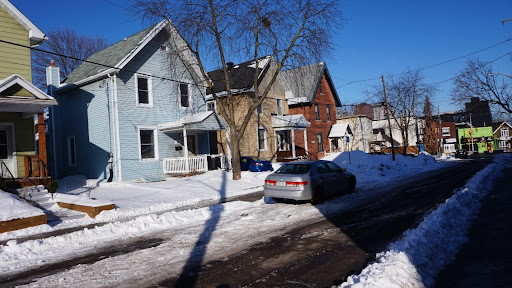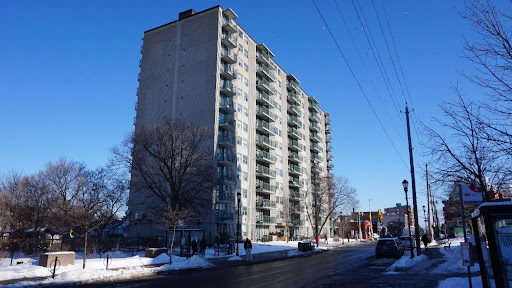Ottawa local Tanya Nash once had a friend come over to her house and say, “For someone who doesn’t make a lot of money, you sure live very well.”
This comfortable lifestyle is all thanks to the Hintonburg East Buy Nothing group, Nash said.
The group is part of the broader Buy Nothing Project—a movement encouraging neighbours to form small groups and gift goods or skills based upon their needs.
Nash said her friend’s observation rings true.
“We have pretty much everything we need,” she said. “And not just what we need but things that if I had won the lottery, this is what I would go into the grocery store and buy. Because with Buy Nothing, there are no limits on what you can ask for.”
Since its founding in 2013, The Buy Nothing Project has made headlines for its environmental goals, occasional racist and classist incidents and most recently, its community-building during the pandemic.
These headlines speak to the vastness of the now global project and how far its come from its humble beginnings.

Environmentalism and buying nothing: How big is the impact?
As the founders of the Buy Nothing Project, Rebecca Rockefeller and Liesl Clark of Puget Sound, WA set the tone for their movement and for the people who participate.
In the ‘About Us’ section of their website, Rockefeller and Clark describe how the project began as just two friends cleaning up plastic from their local beach.
“We spent years collecting and inventorying those plastics and learned that they come from each of us, from our homes, our cars, our workplaces,” the website states. “We started the Buy Nothing Project in an effort to stave off pervasive plastics in every ecosystem on Earth by encouraging each of us to buy less and share more.”
The Buy Nothing Project now exists “for the sole purpose for building community,” according to the website.
Sherose Badruddin, volunteer media lead for the Buy Nothing Project, said its volunteers put a lot of effort into creating an environment focused on neighbourhood connections.
Ottawa’s Hintonburg East Buy Nothing group’s connection to the project’s environmentalist origins is alive and thriving.
Sophia Wong, an administrator of the Hintonburg East Buy Nothing group, said Buy Nothing groups check three boxes for her: thrifting, community building and environmentalism.
“By nature, I’m made for this group,” Wong said. “I am very frugal.”
To Wong, the fact that an item is second hand doesn’t matter. She said she appreciates the vintage, used patina of a well-crafted second-hand item.
Wong’s willingness to buy second-hand is partly fuelled by her passion for the environment. According to data from Statistics Canada, common Buy Nothing items such as textiles or electronics are sizeable contributors to municipal waste.
Textiles, wood, electronics and other bulky objects make up approximately 20 per cent of residual waste in Canadian households, according to Environment and Climate Change Canada.
However, there haven’t been any studies done on how Buy Nothing groups affect the waste production of the neighbourhoods in which they operate. This leaves their environmentally-friendly intentions unproven by published evidence.
The risk of gentrification, classicism and racism
While the desire to be environmentally friendly may fuel their interest, Buy Nothing group participants also have to consider who they’re engaging within the group to consider if they’re contributing to other issues including gentrification.
Gentrification is a process in which wealthy or middle-class individuals move into a historically lower-income neighbourhood, renovating or rebuilding local homes and businesses. It raises property values and displaces less-privileged residents who can no longer afford the higher cost of living in the area.
Sarah Todd, a sociologist at Carleton University, said gentrification can be a looming concern in Buy Nothing groups.
“There’s a danger that [in Buy Nothing groups] there can be conversations about the kinds of people one wants to share one’s stuff with,” Todd said. “Who does one want coming to one’s door to pick up items? Where are the boundaries, who gets let in and who doesn’t get let into these groups?”
With these questions looming, these groups have the potential to turn to social exclusion, according to Todd.
The Buy Nothing Project recommends individuals who gift items in a group choose a giftee randomly, like drawing a name from a hat. However, this recommendation isn’t always ideal if the gifter needs the item gone quickly, in what’s called a “flash give.”
Some members, like Julie Bédard, occasionally choose a giftee purposefully. Bédard is a Hintonburg East local and has been a Buy Nothing group member for about five years. She said she often gifts randomly, but not always.
“The way I choose people can be sometimes based on my perception of how much they might be struggling in life,” Bédard said. “I have a soft heart for people asking for their schools or a single mother.”
Bédard chose to gift a humidifier, which she estimated was worth about $150, to a young woman who she thought would have been the least able to afford it otherwise.

When Buy Nothing groups become too large, they split into several smaller groups through a process called ‘sprouting.’
Marieke Annelie, an administrator of the Hintonburg East group, said the Hintonburg East group sprouted from a larger group which included Ottawa’s Westboro neighbourhood. This split drew a consequential red line between Westboro and Hintonburg East.
When this happened, Annelie said some people in Hintonburg East were unhappy about the fact Westboro residents would no longer be able to gift items to them.
“I remember people saying ‘But all the good gifts are in Westboro,’ and that actually hurt me, because I was like, ‘It’s not gifts. It’s people,’” Annelie said.
When the group split up, Annelie said some members left the Hintonburg East group. This underlying theme of classism left her feeling disheartened because she felt the departing members didn’t understand the mission of the Buy Nothing group.
Gentrification is innately connected to classism and often racism, according to a study in the American Journal of Sociology. People of colour are often disproportionately impacted by gentrification, whereas white people often benefit from it, the research states.
A neighbourhood called Jamaica Plain in Boston drew media attention in 2018 when its group was forcefully split by regional and international administrators of the Buy Nothing Project. Local members complained the split was based on socioeconomic status and felt that it segregated people of colour from their white neighbours.
“We exist in a world of inequality, so what we build within that system has the potential to be co-opted into it,” Todd said.

The administrators of the Hintonburg East group aren’t concerned about the potential gentrification of the group at this time. They said individuals are let into the group solely based on the fact that they live within Hintonburg.
“Everyone has something to bring to the table,” Annelie said. “The thing that you bring to the table can be a grain of rice or a million dollars. It doesn’t matter because it’s you that you’re bringing to the table.”
Annelie said Hintonburg East is a diverse area, where some people live in subsidized apartment buildings and others live in “really fancy condo buildings.”
But the part of Hintonburg members live in is irrelevant to Annelie.
Buy Nothing groups are ‘mutual aid’ projects, meaning the community organizes and facilitates itself. This compares to a professional organization, where employees such as social workers enter a community from the outside to facilitate it.
Todd said the independence of mutual aid groups can be a strength and a weakness when trying to avoid gentrification, classicism, racism and other forms of discrimination.
“It relies on the people within the groups to do some self-policing,” Todd said. “It relies on people within the group saying ‘No, actually, this isn’t part of why I joined this group. I don’t want to exclude.’”
Decisions about behaviour have to be made independently, Todd said, without intervention from overarching moderators.
“The minute that anybody else starts regulating a mutual aid group, then it’s no longer doing the social solidarity building that it’s intended to,” she said.
Community building during a pandemic
Badruddin said she thinks the pandemic had an equalizing effect on the members of Buy Nothing groups.
“Another thing we noticed [in these groups at the start of the pandemic] is the different types of asks and gifts,” Badruddin said.
When items were running out in stores, like toilet paper, it impacted everyone.
“In that way, it kind of equalized [group members]. You know, if you didn’t believe that we were all equal, you do now,” she said.
Administrators of the Hintonburg East group, like Tanya Nash, also noticed the gifts people asked for and received changed at the start of the pandemic.
When the pandemic began, Nash said the administrators decided not to shut down the Hintonburg East group because they knew people in their area might need support during this time.
“We knew that some of our neighbours would have a much harder time getting food,” Nash said. “[And] that anyone on Ontario Works or ODSP would not have the money for masks or hand sanitizer, or all these things you need to have your basic needs met … We really wanted people to feel safe asking for those things.”
According to Statistics Canada, as of February 2021, one-fifth of adult Canadians said it was difficult for them to cover their necessary expenses. More than 50 per cent of adults were worried COVID-19 posed “a major threat to their personal financial situation.”
One new service Buy Nothing members provided for one another in Hintonburg East at the start of the pandemic was grocery shopping. As a single mother, Nash said having a neighbour drop off groceries for her was “a lifesaver” because she wasn’t able to bring her kids to the grocery store.
“I had a lot of different community members say ‘Hey, I’m putting an order in for curbside pickup. Anyone who wants to add things on, send me your list,’” she said. “So, I’d pay for the groceries, but they would just add it to their curbside pickup and then deliver it to me.”
Annelie was one of the neighbours who shopped for Nash. Annelie said she was already buying groceries for her elderly parents, so she didn’t mind picking up orders for her neighbours.

Annelie said one neighbour she picked up groceries for left her a thank you card on a particularly hard day. A different neighbour, Beth Farley, offered to take Annelie’s cat to the vet when the cat had COVID-19.
“My cat ended up getting COVID from me but I was super sick and I couldn’t get her to the vet,” Annelie said. “Someone from the Buy Nothing group picked her up, took her for me, brought her back and then later that night came by with a meal.”
Annelie began to tear up while describing how her cat was her only company at home through much of the pandemic. She said how grateful she was to Farley, who, after taking Annelie’s cat to the vet, returned with beef stew.
“It’s hitting me again how valuable that was to me and how down and out I was,” she said.
For Annelie, the people found and the relationships built in Buy Nothing groups overcome any issues that have arisen within these communities.
“It’s so incredibly powerful, the bonds that you make,” she said.
Featured graphic by Angel Xing.






